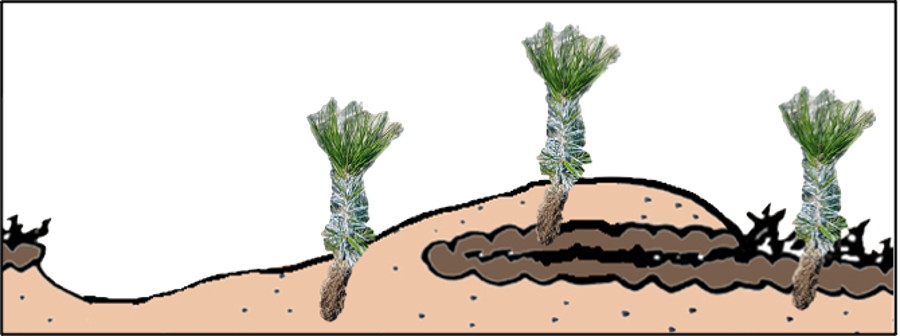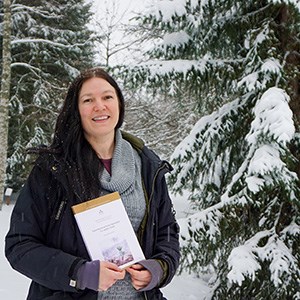You worked on boreal forest regeneration in a variable climate. What motivated you to choose this PhD project in Annika Nordin’s research group at UPSC and SLU?
Bodil Häggström: Boreal forest regeneration was my first “summer job”. I was planting spruce and pine seedlings when I was a teenager. This was a common summer job when growing up in the Northern inland of Sweden. Later on, I also worked as a “planting-boss”, looking that the planters were planting the trees correctly. I always cared greatly to see that seedlings were planted in the right way, both when I was a kid and later. It is the same when I am gardening, I do not like when any sort of seedling is wasted. I guess it is in my nature to “save plants” and that was what caught my attention when I saw this PhD project.
Which factors are limiting forest regeneration, especially in boreal forests?
Bodil Häggström: All factors that make growth slower are limiting such as the short growing season, cold soil temperatures and competition from mature trees and ground vegetation for nutrients like nitrogen, water and light. Seedling growth can also be affected by allelochemicals produced for example by bilberries and lingonberries which represent the most common ground vegetation in Swedish forests. Those compounds can affect both seed germination and root growth. Initial slow growth makes seedlings vulnerable for a longer time. Then, there are of course also pests and insects like the pine weevil that can affect seedling growth and forest regeneration. In the North, this was previously not such a big problem as further south, but with the changing climate the pine weevil and other insects and pests might spread more also here. Browsing by different herbivores also pose a hinder for optimal growth.
What do you consider as the major outcome of your thesis?
Bodil Häggström: In my studies, I have evaluated the effect of planting position, environmental conditions, seedling size, arginine-phosphate addition and competition with mature trees on seedling survival and growth. My major outcome is that there is no one universal regeneration practice that works well everywhere because all sites comprise a unique combination of abiotic and biotic factors that affect the outcome of any practice. For example, the benefit of higher nutrient availability and temperature in a capped mound is counteracted in dry conditions. If a seedling does not get enough water, it cannot utilize the other resources either.
Did your results match your expectations or working hypotheses?
Bodil Häggström: Yes and no, since the results varied quite a lot. We expected higher growth on positions in capped mounds, but this was only on some sites the case. The addition of arginine phosphate as a slow-release organic nitrogen fertilizer enhanced survival and growth on some sites. On other sites, the effect of the local conditions, species and seedling size appeared stronger than or interfered with the effect of fertilization.
What kind of challenges did you had to overcome during your PhD?
Bodil Häggström: The most challenging part for me was the long-term commitment - to focus on one topic over a longer period than I have ever done before. I am that type of person that in general focus on different things in shorter periods, finding a lot of things interesting. During my PhD, I was finding lots of interesting side tracks, and it has been tough to stay focus on what I was supposed to do. Then, there was of course the covid-19 pandemic. I enjoyed a lot the networking part with my colleagues and in the frame of the industrial graduate school that I was part of, but all this came to a halt during the pandemic which made my PhD time less enjoyable than it could have been. Now, after the pandemic, it is much better, and I am intrigued again to continue doing research.
Can you give some practical tips to forest managers based on your results?
Bodil Häggström: Yes, in the light of increasing drought periods in springtime when many seedlings are planted, it would be good to diverge also in Northern Sweden from the general recommendation of planting in the capped mound in dry conditions. Instead, it would be better to try to assess the local conditions before deciding planting position. In drought prone areas for example, planting in the mineral soil beside capped mounds is more favourable while on more moist ground in which there is a risk of waterlogging or frost heaving, planting in capped mounds is better.
Diversifying the planting recommendations could be an easy way to increase survival rates. This is of course a challenge because there is also a need to keep the planting instructions simple, but I think it might be worth it. Hundreds of millions of seedlings are planted every year and only saving one percent would mean saving millions of seedlings. For example, 400 million seedlings - mainly pine and spruce - were delivered in 2020. Increasing survival with one percent would save four million seedlings which is a lot when considering the efforts and costs that are invested to grow a seedling.
Was it beneficial for you to be part of the industrial research school?
Bodil Häggström: Yes, it was highly beneficial! I got contacts in the industry that I otherwise might not have had now, especially with my supervisors from my host company Sveaskog and from Skogforsk. Throughout the years, I was continuously in contact with them, and I now also started the industrial part of my PhD at Sveaskog and will see different parts of the company which is a great opportunity. I wanted to gain as much knowledge as possible before doing my internship. That is why I chose to do it during the last year of my PhD, and I hope that I can now apply my gained knowledge by working on different projects within the company.
Then, in the beginning of my PhD education, I could join a study visit to Australia and New Zealand that was arranged by the industrial research school. That was an amazing journey! We got to visit both forest industry companies and research facilities like Scion in New Zealand. It was great to get early on this perspective and see how forests are managed in other parts of the world which is very different in Australia and New Zealand than in Sweden.
What are you planning to do now?
Bodil Häggström: As mentioned before, I am currently working as trainee at Sveaskog doing my industrial part until November this year. After that I do not know yet, but I could imagine continuing to work at the bridge between academia and industry. I think there are in general more bridges between science and the practice needed but I will see where I end up. Many doors are still open.

